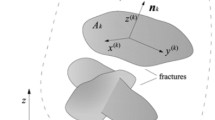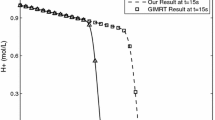Conclusions
A mathematical model is presented for the coupled process of solute and heat transport by the flow of water along a single fissure, with an accounting for the thermal loads induced in the surrounding rock mass. The Barton-Bandis model has been used in describing the fissure behavior. Computer codes have been developed for the conditions of constancy of water flow rate and constancy of pressure drop along the fissure, and these codes have been used in conducting numerical experiments. Analysis of the results has shown that the selected model gives a physical description of the processes of heat and mass transport along a fissure, the warmup of the surrounding mass, and the behavior of the fissure aperture; hence we can rely on successful use of this procedural "tool."
Similar content being viewed by others
References
L. Jing, C.-F. Tsang, and O. Stephansson, "DECOVALEX — an international cooperative research project on mathematical models of coupled THM processes for safety analysis of radioactive waste repositories," Int. J. Rock Mech. Min. Sci. Geomech. Abstr.,32, No. 5, 389–398 (1995).
N. Barton, S. Bandis, and K. Bakhtar, "Strength, deformation and conductivity coupling of rock joints," Int. J. Rock Mech. Min. Sci.,22, 121–140 (1985).
J. Bear and A. Verruijt, Modeling Groundwater Flow and Pollution, D. Reidel, London (1990).
N. Barton and S. A. Yufin, "Prospects for development of numerical methods for geomechanical support for designs of structures in nuclear technology," in: Material from International Conference, "Utilization of Underground Space of the Country for Increasing the Safety Level in Nuclear Energy," 1992, Part 2, Problems in Construction and Safety Provisions for Underground Atomic Stations [in Russian], Apatity (1995).
The McGraw-Hill Handbook of Essential Engineering Information and Data [edited by Ejup N. Ganic and Tyler G. Hicks], McGraw-Hill, New York (1991).
B. Van Lear, "Towards the ultimate conservative difference scheme," J. Comput. Phys.,14, 361–370 (1974).
A. A. Baklanov, Numerical Modeling and Mine Aerology [in Russian], Kola Branch, Academy of Sciences of the USSR, Apatity (1987).
S. Patankar, Numerical Heat Transfer and Fluid Flow, Hemisphere Publishing Corp., New York (1980).
P. A. Cundall, "UDECA generalized distinct element program for modelling fractured rock," Peter Cundall Assoc., Report PCAR-1-80, European Research Office, U. S. Army, Contract DAJA37-79-C-0548 (1980).
E. Elsworth and R. E. Goodman, "Characterisation of rock fissure hydraulic conductivity using idealised wall roughness profiles," Int. J. Rock Mech. Min. Sci. Geomech. Abstr.,23, No. 3, 233–43 (1986).
P. Amossov and M. Gutierrez, "Numerical modelling of the ID advection-diffusion equation and application to solute and heat flow and transport along single fractures," Norwegian Geotechnical Institute, Report 541004-2, November 28, 1995.
Additional information
Mining Institute, Kola Scientific Center, Russian Academy of Sciences, Apatity. Geotechnical Institute, Oslo, Norway. Translated from Fiziko-Tekhnicheskie Problemy Razrabotki Poleznykh Iskopaemykh, No. 1, pp. 26–32, January–February, 1998.
Rights and permissions
About this article
Cite this article
Amissov, P.V., Gutierrez, M. Investigation of heat and mass transport along a single fissure in a rock mass, by means of numerical modeling methods. J Min Sci 34, 21–26 (1998). https://doi.org/10.1007/BF02765521
Received:
Issue Date:
DOI: https://doi.org/10.1007/BF02765521




